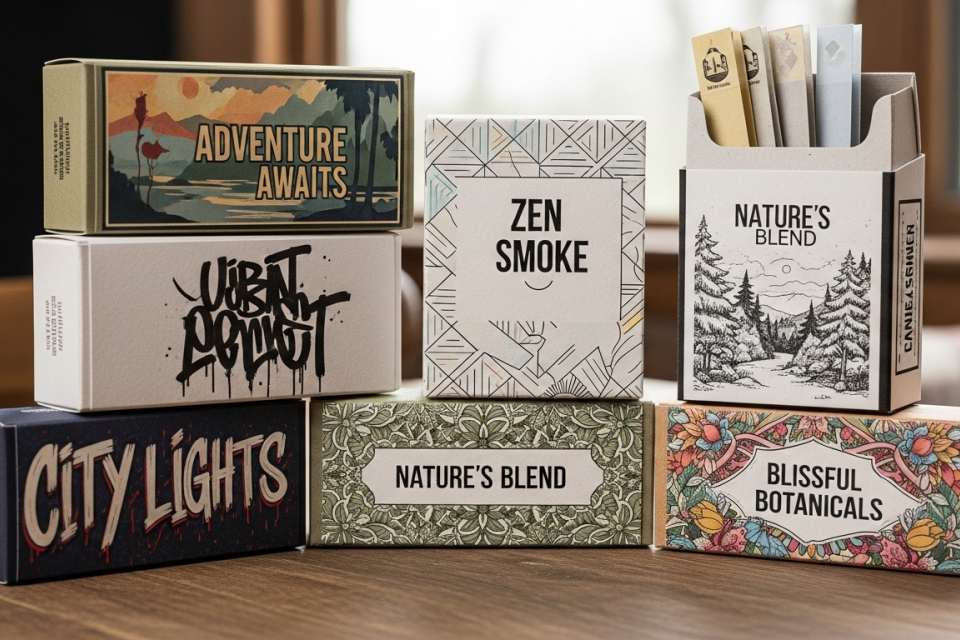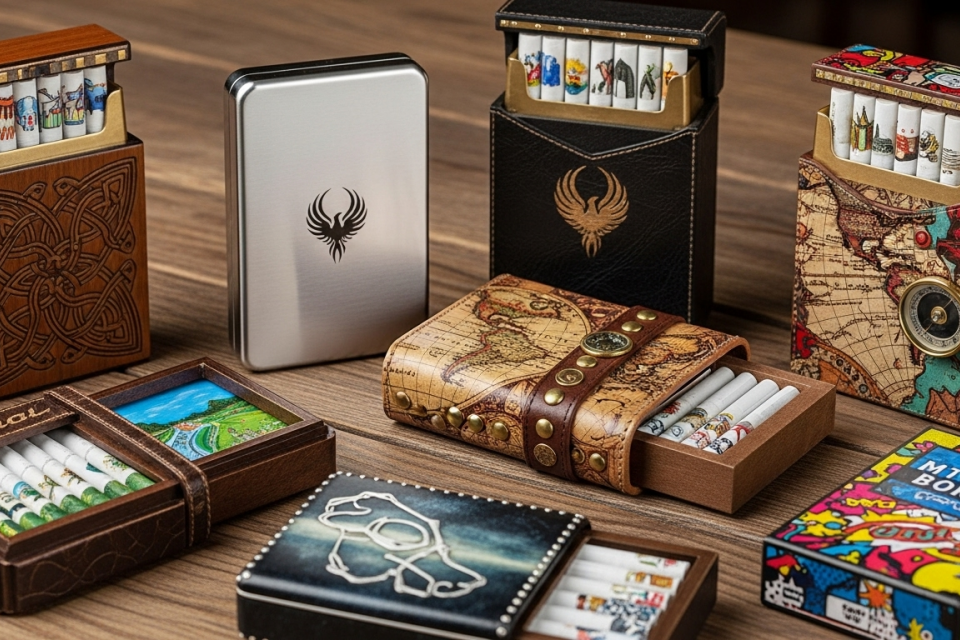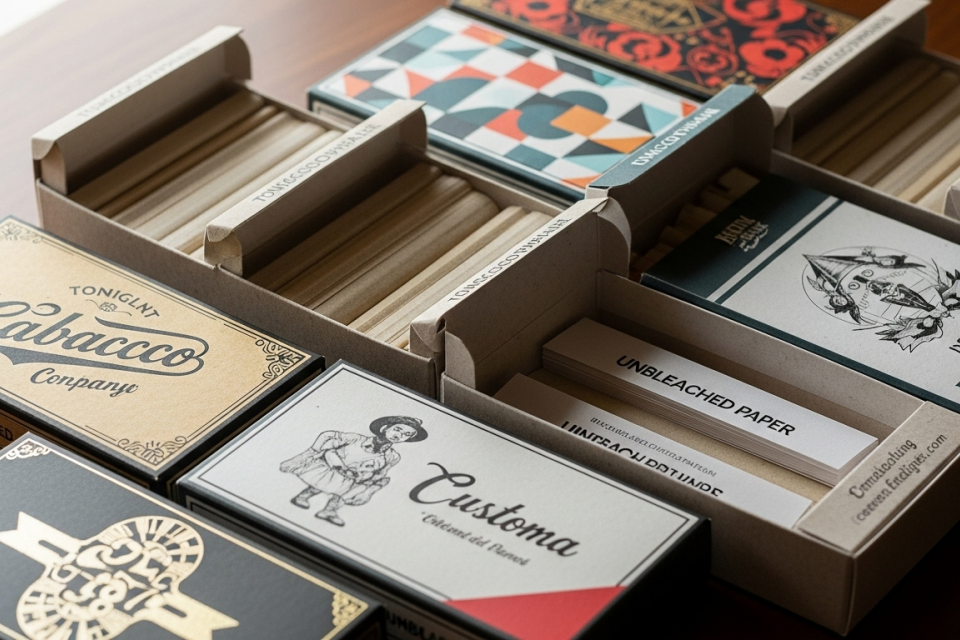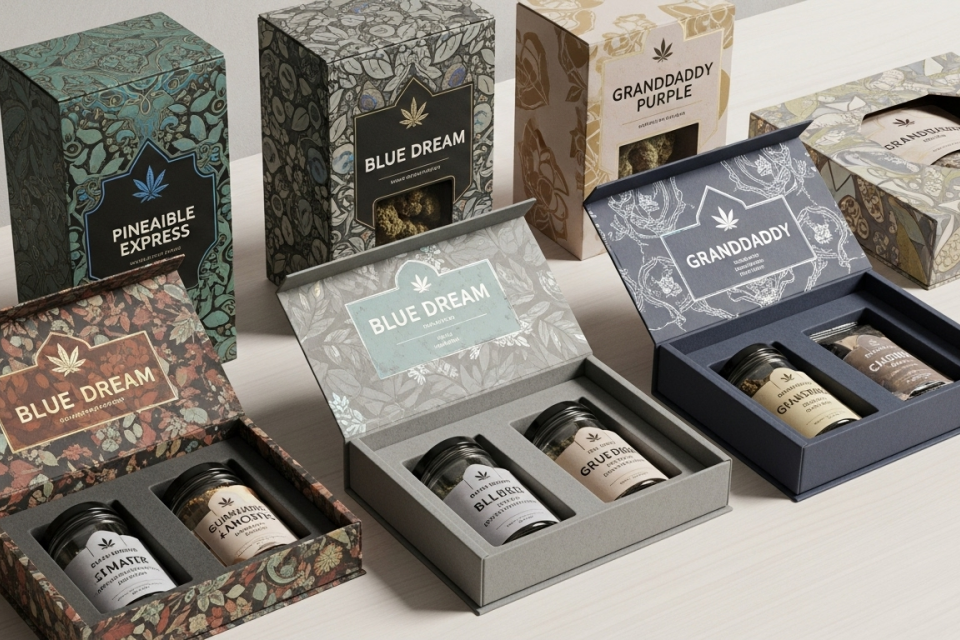Variety of Cannabis Packaging
This article explores cannabis packaging, covering materials, design, regulations, child-resistance, and the growing trend toward sustainability in the market.
Summary
Cannabis packaging refers to the various materials and designs used to safely contain and market cannabis products, playing a crucial role in ensuring product safety, regulatory compliance, and brand differentiation. As the cannabis industry expands globally, the importance of innovative and sustainable packaging solutions has gained prominence, with a projected market growth reaching $1.99 billion by 2025. This growing market has led to the adoption of eco-friendly materials and smart technologies that enhance consumer engagement and align with modern sustainability values.
The most commonly utilized materials in cannabis packaging include plastic, glass, metal, and paperboard, with an increasing emphasis on sustainable alternatives like hemp-based plastics and compostable pouches. Different cannabis products require tailored packaging solutions, such as child-resistant containers for edibles and specific designs for concentrates and dried flowers. These packaging formats are not only essential for maintaining product freshness and compliance with safety regulations but also serve as a critical touchpoint for consumer experience and brand identity.
As the industry evolves, notable trends have emerged, including the integration of smart packaging technologies, which utilize QR codes and NFC capabilities to provide consumers with detailed product information, thereby enhancing transparency. Furthermore, brands are increasingly prioritizing minimalist designs that resonate with a broader audience, moving away from traditional cannabis imagery to attract diverse consumer demographics. The packaging design process has become a strategic element for brands seeking to differentiate themselves in a saturated market, emphasizing aesthetics, functionality, and sustainability.
However, the cannabis packaging sector faces significant challenges, particularly in navigating complex regulatory landscapes and balancing safety requirements with consumer accessibility. Child-resistant packaging must not only comply with legal standards but also be user-friendly for adult consumers, creating a tension between safety and convenience. Additionally, the transition towards sustainable materials presents operational hurdles, prompting brands to innovate while maintaining compliance and cost-effectiveness in their packaging strategies. As the market continues to mature, the emphasis on responsible packaging practices will be essential for fostering consumer trust and ensuring long-term brand loyalty.
Table of Contents
Types of Cannabis Packaging
Cannabis packaging encompasses a variety of materials and designs tailored to different cannabis products. These packaging solutions are essential not only for product safety and compliance with regulations but also for enhancing brand image and consumer experience.
Common Packaging Materials
The most frequently used materials for cannabis packaging include plastic, metal, glass, and paperboard. These materials offer varying degrees of sustainability and consumer appeal. For instance, eco-friendly alternatives such as plant-based hemp plastic and reclaimed materials are gaining traction as brands strive to align with sustainability values.
Packaging for Different Cannabis Products
Different cannabis products necessitate specific packaging solutions. For dried flowers, options often include plastic or glass jars, Mylar bags, or steel cans. Concentrates typically use small cups, syringes, or bottles equipped with droppers. Edibles are generally packaged in resealable pouches, jars, or blister packs, which help maintain product freshness while ensuring compliance with safety standards.
Specialized Packaging Formats
For Flower Products: Common formats include glass or plastic jars, Mylar bags, and flexible pouches. These formats are designed to protect the product from environmental factors while being user-friendly. For Concentrates: Small cups, syringes, and specialized containers are utilized to ensure accurate dosing and ease of use. These designs often focus on tamper-proof and child-resistant features. For Edibles: Resealable pouches and jars are popular for edibles, as they offer convenience for consumers and help in maintaining product integrity.
Innovative Packaging Trends
Recent trends in cannabis packaging highlight a move towards sustainability and technological integration. Smart packaging solutions, such as QR codes for product information and tamper-evident seals, enhance the consumer experience and build trust in the brand. Additionally, minimalist design approaches are becoming popular, providing a sophisticated and trustworthy image to consumers.
Reusable and Eco-Friendly Options
The cannabis industry is also exploring reusable packaging materials, including mason jars, small boxes, and compostable flex-pouch bags. These options not only reduce waste but also appeal to eco-conscious consumers who prioritize sustainability in their purchasing decisions. Companies like Original Green Containers and HISIERRA are leading the charge in providing sustainable packaging alternatives that are both functional and environmentally friendly.

Regulations and Compliance
Licensing Requirements
Under the Cannabis Act, a licence is necessary to engage in various activities related to cannabis and industrial hemp. The Cannabis Regulations delineate the specific rules and requirements applicable to each licence class, such as cultivation, processing, and medical sales, along with subclasses like standard and micro licences. This licensing framework is designed to ensure the legal production of cannabis while minimizing public health risks and curbing the diversion to the illicit market.
Packaging and Labelling Amendments
Health Canada is currently proposing several amendments to the Regulations, which include enhancing packaging and labelling requirements. Among the changes proposed is the allowance for expanded label panels, such as peel-back and accordion labels, for any immediate containers, not just those of smaller sizes. This amendment aims to facilitate licensed processors in providing comprehensive product information to consumers without necessitating changes to container sizes.
Furthermore, stakeholders have suggested the inclusion of informational inserts or leaflets within cannabis product packaging as a method to provide consumers with additional details. Although currently prohibited, this change is under consideration, with the intention that any provided information adheres to the promotion requirements set forth by the Act and its associated Regulations.
Compliance and Enforcement
To uphold compliance, Health Canada employs a range of measures that may include issuing warnings, amending or revoking licences, and imposing administrative monetary penalties of up to $1 million for violations of the Act. The Controlled Substances and Cannabis Branch, alongside the Regulatory Operations and Enforcement Branch, continues to conduct regular inspections and compliance activities to ensure adherence to established regulations. Health Canada collaborates with various partners, including law enforcement and provincial authorities, to bolster its compliance efforts.
In recognition of the need for adaptability, the amendments to the Regulations will also streamline record-keeping and reporting requirements. Health Canada aims to alleviate the burden of excessive documentation, particularly for low-risk activities, while still ensuring essential oversight and public safety.

Design and Branding
Importance of Packaging Design
Packaging design plays a critical role in capturing consumer attention and conveying brand identity within the competitive cannabis market. Brands are increasingly employing bold designs, innovative shapes, and unique materials to stand out and resonate with their target audience. As consumers lean towards premium experiences, luxurious packaging elements—such as soft-touch finishes, foil stamping, and embossing—enhance the perception of quality and elevate the unboxing experience. This focus on premium packaging is essential, particularly as the cannabis industry expands its reach to wealthier demographics.
Visual Storytelling
Artistic illustrations and photography are pivotal in establishing a brand’s personality and mood. Through creative visuals like abstract graphics and nature illustrations, cannabis brands can differentiate themselves and build recognition. Close-up imagery of the product can communicate quality and excite consumers, while educational illustrations help inform users about the effects and proper dosage of cannabis products. Successful brands utilize these visual storytelling components to create a narrative that connects with customers on a deeper level, ultimately driving loyalty and repeat purchases.
Compliance and Safety Considerations
In addition to aesthetic factors, cannabis packaging must comply with state regulations, which can include requirements for childproof and tamper-evident features. Brands that prioritize compliance can avoid legal penalties and foster trust among consumers. Understanding the regulatory landscape is crucial as each state has its own set of rules regarding packaging standards. Ensuring packaging is both visually appealing and compliant not only protects the brand but also reinforces consumer confidence.
The Role of Innovation
As the cannabis market evolves, innovative packaging solutions that cater to changing consumer preferences are becoming increasingly important. Brands are leveraging technology for tracking and compliance while also focusing on sustainable practices to attract environmentally conscious consumers. A thoughtful design approach that integrates elements of sustainability can further enhance brand loyalty and customer satisfaction. By prioritizing user experience in the packaging design process, brands can create lasting impressions and foster trust.
Future Trends
Looking ahead, the cannabis packaging landscape will likely see continued innovation, with an emphasis on personalization and unique unboxing experiences. As brands strive to differentiate themselves, integrating storytelling into packaging design will be crucial for resonating with consumers and maintaining relevance in an oversaturated market. Companies that invest in high-quality, well-thought-out packaging will not only stand out on dispensary shelves but also create lasting relationships with their customers.

Innovations in Cannabis Packaging
The cannabis packaging industry has experienced significant innovations driven by technological advancements, sustainability concerns, and changing consumer preferences. As legalization continues to expand globally, brands are exploring creative and effective packaging solutions to differentiate themselves in a competitive market.
Sustainable Packaging Solutions
One of the most notable trends in cannabis packaging is the shift towards sustainable materials. Companies are increasingly using plant-based materials, such as hemp plastic and recycled paper, which reduce reliance on fossil fuels and minimize carbon footprints. For instance, brands like Wyld have introduced compostable pouches, while others are utilizing hemp-based packaging to align with the cannabis ethos itself. This move towards sustainability not only helps the environment but also resonates with eco-conscious consumers, potentially increasing brand loyalty and sales.
Smart Packaging Technologies
Technological innovation has led to the rise of smart packaging solutions in the cannabis sector. Features such as QR codes allow consumers to scan packaging for additional product information, including lab test results and origin details, enhancing the transparency of cannabis products. Moreover, advancements like Near Field Communication (NFC) offer seamless interactions between products and consumers’ smartphones, enriching the overall user experience.
Creative and Minimalist Designs
The evolution of cannabis packaging design has also seen a movement towards minimalist aesthetics. This design philosophy employs simple, clean lines and limited color palettes to evoke sophistication and trust among consumers. Innovative packaging not only helps brands stand out but also creates a more inviting consumer experience, moving away from the traditional imagery of cannabis leaves which might deter some customers.
Child-Resistant and Tamper-Evident Features
With safety regulations becoming increasingly stringent, child-resistant and tamper-evident features are essential in cannabis packaging. These measures ensure that products are inaccessible to children and maintain product integrity until consumption. The implementation of tamper-evident seals and opaque packaging reduces the risk of unauthorized access and minimizes appeal to minors, fulfilling both regulatory requirements and consumer trust.

The Future of Packaging
As the cannabis industry continues to mature, further innovations are anticipated. Brands are likely to explore more compostable materials and reusable packaging options, supporting a circular economy while addressing waste concerns. The industry’s shift from single-use plastics towards more sustainable alternatives like glass and metals signifies a broader commitment to environmental responsibility. With these advancements, the cannabis packaging sector is poised to continue evolving in ways that meet regulatory demands and consumer expectations alike.
Market Trends
The cannabis packaging market is experiencing significant growth, driven by increasing legalization and evolving consumer preferences. The market is projected to reach $1.99 billion by 2025, with a compound annual growth rate (CAGR) of 15.46% through 2030. As the industry matures, brands are faced with both challenges and opportunities that influence packaging design and strategy.
Sustainability as a Priority
A key trend in cannabis packaging is the push for sustainability. Research indicates that over 72% of consumers prefer eco-friendly packaging options, prompting brands to adopt biodegradable materials such as hemp-based plastics and recycled paper. Additionally, reusable and refillable packaging solutions are becoming more common, as brands seek to minimize waste and align with consumer values regarding environmental responsibility. The adoption of compostable pouches for edibles and the use of soy-based inks further reflect this trend.
Technological Innovations
Technology integration into cannabis packaging is reshaping the consumer experience by enhancing transparency and engagement. Smart packaging solutions, including QR codes, allow consumers to access information about product sourcing, safety, and usage, catering to a growing demand for informed purchasing decisions. As regulatory demands evolve, brands are also looking to build flexibility into their packaging designs to adapt to changing compliance requirements.
Navigating Regulatory Changes
As cannabis legalization expands across various states, brands must navigate a complex landscape of regulatory requirements. This includes implementing child-resistant mechanisms and food-grade packaging to meet safety standards. The failure to pass federal tax or banking reforms has compounded these challenges, creating a need for brands to stay attuned to local regulations while managing their packaging strategies. Building relationships with compliance-ready suppliers and participating in industry associations are vital for brands aiming to remain compliant and competitive.
Consumer-Centric Design
In a crowded market, packaging is becoming a critical differentiator for cannabis brands. Bold designs, unique materials, and innovative shapes are being utilized to capture consumer attention and convey brand identity. Brands are increasingly focusing on creating aesthetically pleasing and functional packaging that enhances the user experience and encourages repeat purchases. This emphasis on quality design is essential as it builds consumer trust and loyalty, making packaging a crucial aspect of brand strategy in the competitive cannabis landscape.
Challenges in Cannabis Packaging
Cannabis packaging presents a unique set of challenges due to regulatory requirements, safety considerations, and evolving consumer expectations.
Regulatory Compliance
One of the primary challenges faced by cannabis producers is navigating the complex and ever-changing legal frameworks governing packaging. Different jurisdictions have distinct regulations that must be adhered to, making compliance a multifaceted task. Companies often invest in compliance software, engage with regulatory consultants, and educate their staff to ensure they remain informed about the latest requirements.
Child-Resistant Features
All cannabis packaging must incorporate child-resistant features to prevent accidental ingestion by minors. However, these safety measures can lead to packaging that is overly difficult for adults to open, particularly for those using cannabis for medical reasons such as managing chronic pain or arthritis. This duality creates a significant challenge in balancing child safety with accessibility for legitimate adult users.
Balancing Cost and Quality
The financial implications of high-quality, compliant packaging are considerable, particularly for smaller producers. Many companies struggle to find a balance between cost-effectiveness and meeting the stringent regulatory standards required for their products. Achieving this balance necessitates innovative thinking, strategic planning, and efficient operational practices, such as investing in high-efficiency packaging machinery and adopting modular design solutions.
Labor Shortages and Automation
The cannabis packaging industry also faces labor shortages, which can hinder processing and packaging efforts. Many companies still rely on manual labor, making it challenging to keep up with rising consumer demand. To address these issues, there is a growing trend towards automation in packaging processes, enabling firms to optimize efficiency and productivity.
Sustainability Considerations
Sustainable packaging has become a significant focus for cannabis brands as consumers increasingly prefer environmentally responsible options. However, the transition to sustainable materials can present operational hurdles, particularly when existing machinery is not compatible with new packaging formats. Companies must innovate and adapt their practices to ensure that sustainability initiatives do not compromise efficiency or profitability.
Case Studies
The cannabis packaging industry has seen significant innovation, with various brands implementing unique strategies that highlight the importance of design, sustainability, and consumer engagement. Below are notable case studies that exemplify successful packaging approaches in this evolving market.
Progressive Treatment Solutions
Progressive Treatment Solutions elevated the packaging for their high-end MOZEY extract flower products by incorporating luxurious elements such as gold foil and UV highlights. This sophisticated design not only enhances the visual appeal but also positions the product as a premium offering within a competitive market.
Brand A’s Luxury Cannabis Jars
Brand A distinguished itself in the cannabis market through its luxury cannabis jars, which effectively targeted a high-end consumer base. By emphasizing premium quality and aesthetics, Brand A was able to command a higher price point, illustrating the pivotal role packaging plays in shaping brand perception and market positioning.
Brand B’s Interactive Cannabis Jars
In a bid to create a memorable shopping experience, Brand B introduced interactive cannabis jars that featured a unique design element allowing consumers to engage with the product prior to purchase. This innovative approach not only attracted attention but also set Brand B apart from its competitors, demonstrating the effectiveness of engaging packaging strategies.
Kiva Confections
Specializing in cannabis-infused edibles, Kiva Confections utilizes vibrant packaging designs that communicate their product’s flavor profiles. Their approach involves earthy colors and nature-inspired symbols, reflecting the brand’s commitment to quality and the natural origins of their products. This thoughtful design has resonated with consumers who appreciate both aesthetics and functionality in packaging.
Pure Beauty
Pure Beauty prioritizes environmentally friendly packaging, utilizing paper packing and developing child-resistant mylar bags made from plant starch. The brand’s commitment to sustainability is reflected in its cultivation practices, which avoid runoff and utilize beneficial insects. By integrating eco-consciousness into their packaging, Pure Beauty appeals to environmentally aware consumers while promoting a positive brand image.
FarmaceuticalRX
FarmaceuticalRX adopts traditional organic methods for cultivating premium cannabis, focusing on sustainability by using recycled living soil and minimizing water usage. Their research and development efforts aim to reduce energy consumption, showcasing how thoughtful packaging and cultivation practices can work in harmony to benefit both consumers and the environment.
These case studies highlight the dynamic nature of cannabis packaging, where innovative designs and sustainable practices are not just trends but essential components of brand identity and market success. By studying these examples, other brands can glean insights into effective packaging strategies that resonate with their target audiences while contributing positively to their brand narrative.
